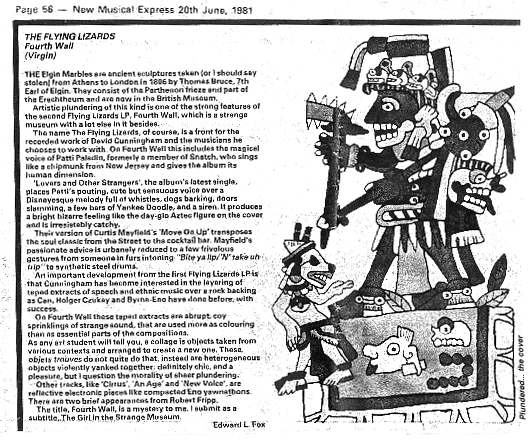Album
Review: "Fourth Wall" LP
- written by Edward L. Fox, appeared in NME, June 20th, 1981

Album
Review: "Fourth Wall" LP
- written by Edward L. Fox, appeared in NME, June 20th, 1981

THE FLYING LIZARDS: "Fourth Wall" (Virgin)
The Elgin Marbles are ancient sculptures taken (or should I say stolen) from Athens to London in 1806 by Thomas Bruce, 7th Earl of Elgin. They consist of the Parthenon frieze and part of the Erechtheum and are now in the British Museum.
Artistic plundering of this kind is one of the strong features of the second Flying Lizards LP, "Fourth Wall", which is a strange museum with a lot else in it besides.
The name The Flying Lizards, of course, is a front for the recorded work of David Cunningham and the musicians he chooses to work with. On "Fourth Wall" this includes the magical voice of Patti Paladin, formerly a member of Snatch, who sings like a chipmunk from New Jersey and gives the album its human dimension.
"Lovers and Other Strangers", the album's latest single, places Patti's pouting, cute but sensuous voice over a Disneyesque melody full of whistles, dogs barking, doors slamming, a few bars of Yankee Doodle, and a siren. It produces a bright bizarre feeling like the day-glo Aztec figure on the cover and is irresistably catchy.
Their version of Curtis Mayfield's "Move On Up" transposes the soul classic from the Street to the cocktail bar. Mayfield's passionate advice is urbanely reduced to a few frivolous gestures from someone in furs intoning "Bite ya lip / N' take uh trip" to synthetic steel drums.
An important development from the first Flying Lizards LP is that Cunningham has become interested in the layering of taped extracts of speech and ethnic music over rock backing as Can, Holger Czukay and Byrne-Eno have done before, with success.
On "Fourth Wall" these taped extracts are abrupt, coy sprinklings of strange sound, that are used more as colouring than as essential parts of the compositions. As any art student will tell you, a collage is objects taken from various contexts and arranged to create a new one. These objets trouves do not quite do that, instead are heterogeneous objects violently yanked together: definitely chic, and a pleasure, but I question the morality of sheer plundering.
Other tracks, like "Cirrus", "An Age" and "New Voice", are reflective electronic pieces like compacted yawnathons. There are two brief appearances by Robert Fripp.
The title, "Fourth Wall", is a mystery to me. I submit as a subtitle, "The Girl In the Strange Museum".